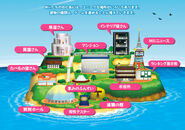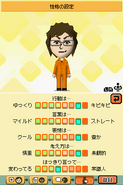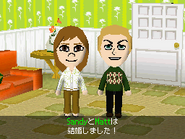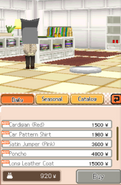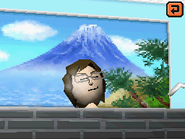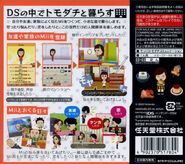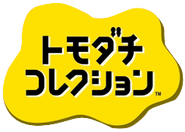| Tomodachi Collection | |
|---|---|
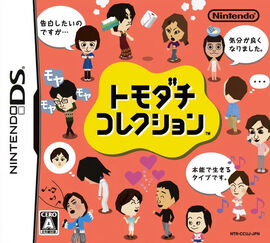
| |
| Developer | Nintendo SPD |
| Publisher | Nintendo |
| Platforms | Nintendo DS |
| Release date | |
| Genre | Life simulation |
| Ratings | CERO- A |
| Website | Official Site (JP) |
Tomodachi Collection (トモダチコレクション Tomodachi Korekushon?, lit. “Friend Collection") is a life simulation game for the Nintendo DS released on June 18th, 2009, exclusively in Japan. It is the first game in the Tomodachi series. A sequel named Tomodachi Life was released in Japan on April 18th 2013, and in America and Europe on June 6th, 2014.
Gameplay
The game takes place on an island in the middle of the ocean, that can be populated with various Miis created from the built in Mii Maker, or transferred wirelessly from a Wii console. These Miis can be given a personal voice and personality based on the player's liking. Once each Mii is made, they will move into their own apartment on the island, allowing them to explore the island and its various facilities. As more Miis are added, more facilities and activities are unlocked, and the Miis may even become friends with one another, hanging out in their apartment or outside.
Miis themselves can also be interacted with in their apartment, allowing the player to give them food, clothes, or an interior for their apartment. Depending on how much they like it, the Mii's happiness will go up, and once it reaches a certain point, the Mii will level up, allowing the player to give them a level-up gift, such as a phrase or a song as a reward. If the Mii is asleep, the player may have a chance to view a dream, leading to a bizarre mini-game, event, or activity.
At certain times, events can be held that the player can witness, be it Street Live at the fountain, or Question at the Question Hall.
Differences in Tomodachi Collection
Compared to the later-released Tomodachi Collection: New Life/Tomodachi Life, Tomodachi Collection has several different gameplay mechanics.
- Tomodachi Collection runs at a smooth 60 frames-per-second, while Tomodachi Collection: New Life runs at 30 frames-per-second.
- The main island is much smaller, consisting of only Mii Apartments, the Town Hall (called City Hall), the Clothing Shop, the Pawn Shop, the Food Mart, Interiors, the Fountain,the Rankings Board, the Compatibility Tester, Mii News, and two buildings not present in Tomodachi Collection: New Life: Question Hall and Job Diagnosis.
- Quirky Questions and Judgement Bay are hosted inside the fore-mentioned Question Hall.
- The Fountain is the only location in the game to hold scheduled events. An "Event" balloon is not shown hovering above it when an event is being held. It also hosts Street Live and English Lesson, which are not present in Life.
- There is no Office in the Mii Apartments. Island info is instead displayed on a billboard outside the apartments, apartments cannot be swapped.
- The Personality chart is accessible in the Town Hall.
- The Town Hall's options are different:
- Send/Receive works differently, allowing users to import Miis directly from a Wii system (as the DS lacks a built-in Mii creator).
- QR Codes are unavailable because they were not introduced by then.
- A save button is not available on the bottom of the touch screen, although the Start button can still be used to quick-Save.
- On the Rankings Board, the island, traveler, and splurge rankings are unavailable.
- The Romance Ranking displays the 20% parings or lower with both Miis angry instead of sad.
- On the island, the day to night transition is much more fluid than depicted in Life.
- Miis can be given one of four blood types.
- This, however, still returned to the Japanese version of Life.
- There are no "Locate" and "Call” options for when a Mii is not at home.
- Miis only have one all-time favorite dish and one worst dish instead of two, lacking the "Super" favorites.
- The animations Miis make when they eat their favorite/worst favorite are different.
- Hats and hair dye are not available.
- If the item intended to be given to a Mii is launched high in the room, falling behind the Mii, it becomes horrified in shock for a few seconds, before turning his/her head back towards the tossed item and walking over to pick it up. In Tomodachi Collection: New Life, they turn their head towards the thrown item almost immediately.
- Songs are performed directly inside the Mii's apartment, rather than inside the Concert Hall.
- Singing Miis also cannot be put into groups.
- The selection of bonuses a Mii can get upon level-up differs:
- The available songs are different, offering six styles rather of eight.
- The selection of gifts a Mii can be given are different, featuring the following:
- Duster
- Laptop
- Study kit
- Novel
- Cell phone (Resembles a classic folding cellphone)
- CD (As a headset rather than a radio placed on the floor)
- Wii (Replaced with the Wii U in Tomodachi Collection: New Life)
- DS (Replaced with the 3DS XL in Tomodachi Collection: New Life)
- Gifts given to a Mii can have different colors, which match the Mii’s favorite color. Since there are exactly eight gifts, Miis can have all eight at once.
- The offered interiors available through level-up also differs:
- Country
- Industrial
- Family
- Natural wood
- Scandinavian
- European
- Miis cannot be given pocket money, therefore Miis cannot go on trips to space. Once the Mii reaches Level 22, the player can no longer give them gifts as they have everything.
- The playable Islander Games differ slightly between Collection and Life, including a few that do not return in Life.
- Likewise, the pseudo-games consist of mosquito and backscratching, the former which was moved to an activity in the Campgrounds, while the latter was removed entirely and replaced with sneezing.
- When Miis go to sleep for the night, their beds are colored the same as their depicted favorite color. In Life, all of the apartment beds are identical, differing only in size.
- Dreams will only produce items if the Mii has the dream while sleeping in bed for the night. Dreams that occur through a napping Mii will not produce any items.
- Collection has a different select of dreams than what is featured in Life.
- Clothing with more than one color has each color variant represented as a separate piece of clothing with their own slot in the list instead of all colors of one clothing sharing the same slot and cycled through with L and R. Clothing with more than one color are read as "Clothing name (Color)".
- In the clothing shop, items given out through special occurrences (such as through dreams) are not added to the shop's list, and they must be re-acquired through the special event.
- Marriage is performed much differently than in Life, with two sweethearts instantly marrying. In later installments, there is a minigame where the player has to help one of them propose to the other.
- Married couples do not get their own living space, as Mii Homes does not exist.
- Babies are unavailable in Collection. Thus, the game's end credits are shown during a marriage, rather than after a child has fully grown.
- StreetPass and SpotPass items are not present in Collection as neither of those two functions have existed.
- The background music in Collection (released in the December 2011 album Tomodachi Collection Platinum Soundtrack) is mostly different from the music in Life. Only a few tracks are shared between the games, such as "City Hall" and "Save Screen".
- Miis can develop feelings for Miis who are already married, and will always get rejected. This is changed in Life; when a Mii gets married, no one will fall in love with them.
- Confessions have four locations (Only the beach, park, school and rooftop), and their actions are also four (only traditional, romantic, arrogant and desperate). There are no interventions.
- Miis can only have normal fights; huge fights are not available.
- In addition, if the apology is rejected, the other Mii won't say they're sick of fighting and want to reconcile. They also will never be friends again.
- The Miis can only take artistic photos with the camera.
- Miis won't ask you to take a look around their apartment after being given a new interior.
- If a Mii has a friendship problems their window will use the grey dust cloud icon, instead of the orange smiley face icon. Sadness problems are purple instead of blue.
- When Miis want to make friends, the Mii they want to befriend will visit the asking Mii's apartment instead of the asking Mii going to the other Mii's apartment. Miis can't introduce two to each other.
Locations
| Location | Image | Information |
|---|---|---|
| Island | 
|
The main hub world in the game, where every other location can be found. |
| Mii Apartments | 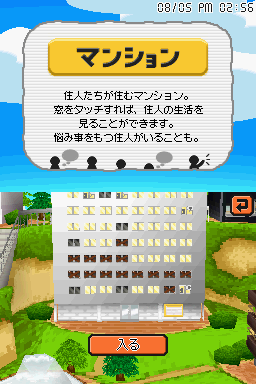
|
Mii Apartments is the apartment building where the player's Miis reside. By tapping on various windows, the player can interact with their Miis. |
| Food Mart | 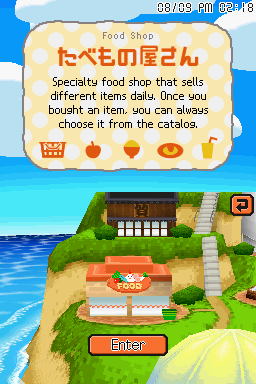
|
The Food Mart is one of four shops featured on the island, after the Clothing Shop, the Interiors Shop, and the Pawn Shop. The Food Mart is where the player can buy various food items to give to their islanders, which updates daily. |
| Clothing Shop | 
|
The Clothing Shop is another store featured on the island, serving as an area where the player can buy clothing for their islander. |
| Interiors Shop | 
|
The Interiors Shop sells interiors to the player, updating every day. The shop is also known to have special interiors every month, as well as other interiors that are unlocked when a Mii reaches a certain level on the Island. |
| Pawn Shop | 
|
The Pawn Shop is an area where the player can sell treasures that they no longer want. |
| Fountain | 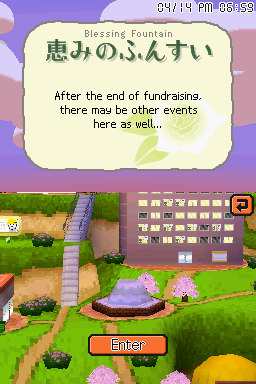
|
The fountain is an area that exists in the island plaza, serving its purpose as a public hangout place where Mii can talk or exercise. The events include donations, English Lesson, Street Live, and Morning Market. |
| Question Hall | 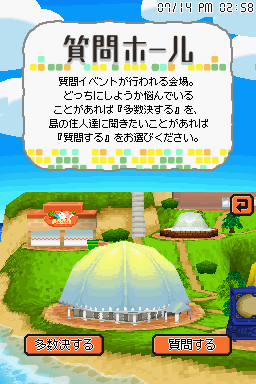
|
The Question Hall is an area that can used to asked Miis quirky questions, or have them vote based on two choices. Either of these can be initiated at any time. |
| Job Diagnosis | 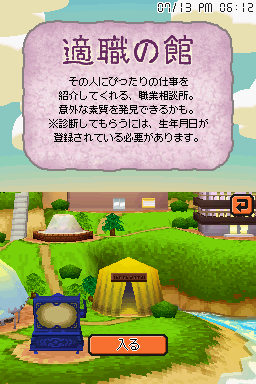
|
The Job Diagnosis is where Miis can be given jobs without the use of a job ticket, such as a dancer, talk show host, or fireworks crafter. This can only be done with Miis that have registered birthdays, however, as a Mii without a birthday cannot be given a job. |
| Mii News | 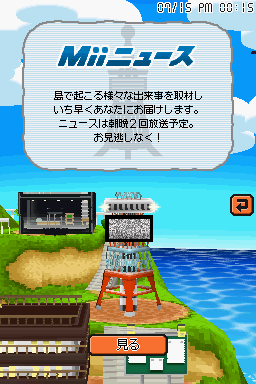
|
Mii News is a news station that broadcasts news at 7:00 AM to 7:00 PM, which range from humorous reports to numerous events that have taken place on the island, such as when a new building opens. Two random Miis can also be seen being interviewed after the report is finished, saying a comment to the news team. |
| Rankings Board | 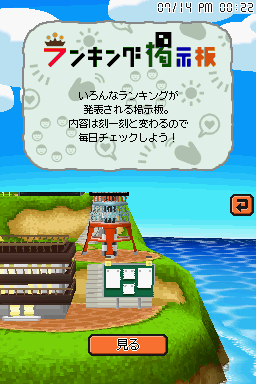
|
The Rankings Board is an area that post rankings based on several factors exhibited by the islanders, such as vitality, level of charm, or level of popularity. |
| Compatibility Tester | 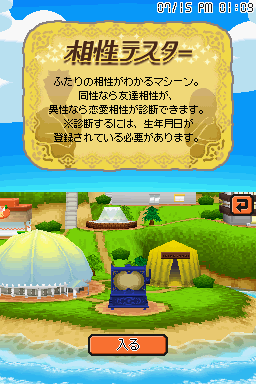
|
The Compatability Tester is a location that analyzes two islanders to determine their level of chemestry. Depending on age and genders used, this can range from a romance rating to a friend rating. |
| Town Hall | 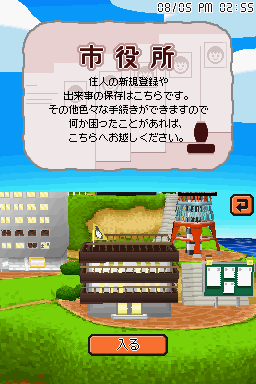
|
The Town Hall is where the player can gather all the information of the island, including its residents, their personalities, and the time on the island. |
Development
The game was developed by Nintendo's SPD group, being directed by Ryutaru Takahashi and produced by video game designer Yoshio Sakamoto, best known for his work in the Metroid franchise also made by Nintendo. The team was mostly made up of younger developers in a small environment. Early in development, the game was to be called "Fortune Telling Notebook for Teenaged Men" and would only feature 13-17 years characters. The game was later reworked to have more focus on life simulation, and thus Tomodachi Collection was made.[citation needed]
A Western localization was not made by Nintendo of America, due to the DS being unable to translate the voice synth into English. Despite this, fan translations exist .
Reception
In Japan, the game has received generally positive reviews. Famitsu gave the game a 29 out of 40. On the day of its release, the game sold over 102,000 units, making it the best-selling DS game in that period. On March 3rd, 2010, Nintendo announced the game had sold 3.2 million copies in total.
Gallery
Official Artwork
Screenshots
Miscellaneous
| Tomodachi series | ||||
|---|---|---|---|---|
| ||||
